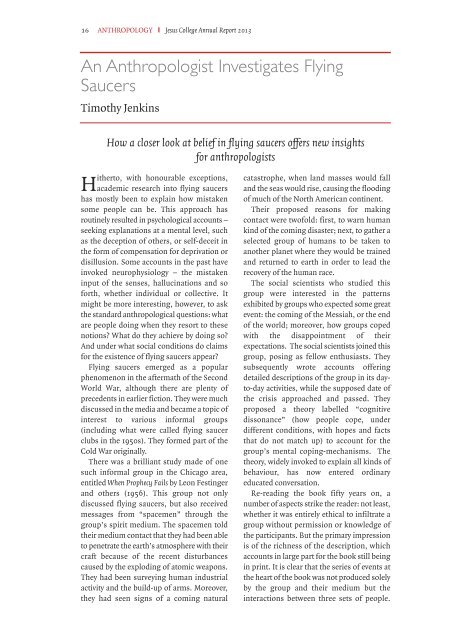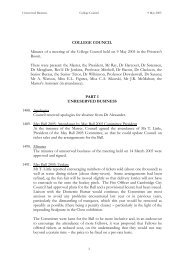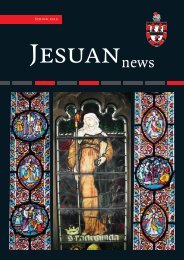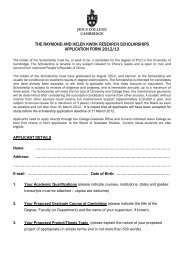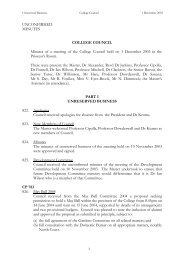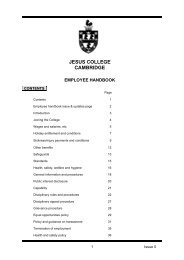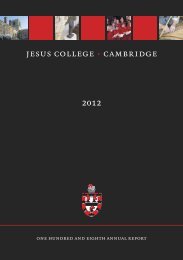2013 Annual Report - Jesus College - University of Cambridge
2013 Annual Report - Jesus College - University of Cambridge
2013 Annual Report - Jesus College - University of Cambridge
You also want an ePaper? Increase the reach of your titles
YUMPU automatically turns print PDFs into web optimized ePapers that Google loves.
16 ANTHROPOLOGY I <strong>Jesus</strong> <strong>College</strong> <strong>Annual</strong> <strong>Report</strong> <strong>2013</strong><br />
An Anthropologist Investigates Flying<br />
Saucers<br />
Timothy Jenkins<br />
How a closer look at belief in flying saucers <strong>of</strong>fers new insights<br />
for anthropologists<br />
Hitherto, with honourable exceptions,<br />
academic research into flying saucers<br />
has mostly been to explain how mistaken<br />
some people can be. This approach has<br />
routinely resulted in psychological accounts –<br />
seeking explanations at a mental level, such<br />
as the deception <strong>of</strong> others, or self-deceit in<br />
the form <strong>of</strong> compensation for deprivation or<br />
disillusion. Some accounts in the past have<br />
invoked neurophysiology – the mistaken<br />
input <strong>of</strong> the senses, hallucinations and so<br />
forth, whether individual or collective. It<br />
might be more interesting, however, to ask<br />
the standard anthropological questions: what<br />
are people doing when they resort to these<br />
notions? What do they achieve by doing so?<br />
And under what social conditions do claims<br />
for the existence <strong>of</strong> flying saucers appear?<br />
Flying saucers emerged as a popular<br />
phenomenon in the aftermath <strong>of</strong> the Second<br />
World War, although there are plenty <strong>of</strong><br />
precedents in earlier fiction. They were much<br />
discussed in the media and became a topic <strong>of</strong><br />
interest to various informal groups<br />
(including what were called flying saucer<br />
clubs in the 1950s). They formed part <strong>of</strong> the<br />
Cold War originally.<br />
There was a brilliant study made <strong>of</strong> one<br />
such informal group in the Chicago area,<br />
entitled When Prophecy Fails by Leon Festinger<br />
and others (1956). This group not only<br />
discussed flying saucers, but also received<br />
messages from “spacemen” through the<br />
group’s spirit medium. The spacemen told<br />
their medium contact that they had been able<br />
to penetrate the earth’s atmosphere with their<br />
craft because <strong>of</strong> the recent disturbances<br />
caused by the exploding <strong>of</strong> atomic weapons.<br />
They had been surveying human industrial<br />
activity and the build-up <strong>of</strong> arms. Moreover,<br />
they had seen signs <strong>of</strong> a coming natural<br />
catastrophe, when land masses would fall<br />
and the seas would rise, causing the flooding<br />
<strong>of</strong> much <strong>of</strong> the North American continent.<br />
Their proposed reasons for making<br />
contact were tw<strong>of</strong>old: first, to warn human<br />
kind <strong>of</strong> the coming disaster; next, to gather a<br />
selected group <strong>of</strong> humans to be taken to<br />
another planet where they would be trained<br />
and returned to earth in order to lead the<br />
recovery <strong>of</strong> the human race.<br />
The social scientists who studied this<br />
group were interested in the patterns<br />
exhibited by groups who expected some great<br />
event: the coming <strong>of</strong> the Messiah, or the end<br />
<strong>of</strong> the world; moreover, how groups coped<br />
with the disappointment <strong>of</strong> their<br />
expectations. The social scientists joined this<br />
group, posing as fellow enthusiasts. They<br />
subsequently wrote accounts <strong>of</strong>fering<br />
detailed descriptions <strong>of</strong> the group in its dayto-day<br />
activities, while the supposed date <strong>of</strong><br />
the crisis approached and passed. They<br />
proposed a theory labelled “cognitive<br />
dissonance” (how people cope, under<br />
different conditions, with hopes and facts<br />
that do not match up) to account for the<br />
group’s mental coping-mechanisms. The<br />
theory, widely invoked to explain all kinds <strong>of</strong><br />
behaviour, has now entered ordinary<br />
educated conversation.<br />
Re-reading the book fifty years on, a<br />
number <strong>of</strong> aspects strike the reader: not least,<br />
whether it was entirely ethical to infiltrate a<br />
group without permission or knowledge <strong>of</strong><br />
the participants. But the primary impression<br />
is <strong>of</strong> the richness <strong>of</strong> the description, which<br />
accounts in large part for the book still being<br />
in print. It is clear that the series <strong>of</strong> events at<br />
the heart <strong>of</strong> the book was not produced solely<br />
by the group and their medium but the<br />
interactions between three sets <strong>of</strong> people.


